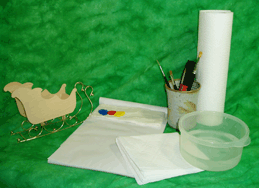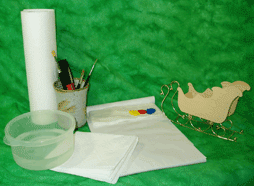How to Paint with Acrylics
The Decorative Painting Way

This page about how to paint with acrylics is for the beginner who wants to learn to paint, or someone who's simply looking to brush up on their skills.
There are many ways to learn painting with acrylics. Here we're focusing on tole and decorative painting instructions.
We like to think of it as the art of making functional and non-functional objects more beautiful.
You'll find lots of information here for what you need to know to set up
and get started. Painless lessons on how to paint with acrylics.
Decorative painting is best learned by taking classes with a good teacher. This allows you to observe, ask questions, and have techniques demonstrated right before your eyes.
We encourage you to take lessons with as many different teachers as possible. You'll be amazed at the unique tips and techniques you'll learn from each one.
Learning how to paint with acrylics requires some supplies to get started.
How to Set Up and Get Started

FOR THE RIGHT-HANDED PAINTER
FOR THE LEFT-HANDED PAINTER

OK, you've assembled your supplies.
Let's get you set up. Find a spot with good lighting. Most of us when we first start just use the kitchen or dining room.
Once you've got a spot, it's a good idea to establish a set-up routine.
· Fill your water container with cold water. Hot water causes paint to dry in the brush hairs ruining your brushes.
· Keep your paints fresh while working with them by setting up a "wet palette" area on your dry palette.
Dampen a double sheet of paper towel folded into a narrow strip. Flatten it out across the top of your dry palette. This gives you a moist area to hold paint puddles.
· You need a blotter for removing excess water and paint. A double sheet of paper towel folded into quarters works nicely.
· Are you left or right handed?
Keep your supplies just off to the side of your dominant hand....palette paper, water container, blotter, and brushes will be the closest. Remaining supplies kept handy as needed.
Learning how to paint with acrylics for decorative painters usually means starting out by painting on wood.
So, let's keep it simple. You'll start by painting the wood rather than staining it.
If you're looking for more detailed information on surface preparations, please read the sections on wood or metalware and other surfaces listed on our Home Page.
Your new mantra is SAND, TACK, SEAL, SAND, TACK.
Besides learning how to paint with acrylics, you're learning a new wood trade, it seems!
These steps are really important though.
To prepare your surface...
- Give your project a light sanding, following the direction of the grain. · Use the tack cloth to remove sawdust. Just remember to wipe lightly with your tack cloth anytime you sand.
- Brush on sealer. A foam brush is a good option. Allow to dry; then lightly sand and "tack" again.
It's time to basecoat your surface. This differs from basecoating the design itself which is discussed further down.
- Foam brushes are good here too. A lightly damp brush is dipped in paint. Blend on the palette to load paint evenly in the brush.
Apply smoothly on the surface following the grain direction. Avoid ridges by feathering out the paint.
- It takes at least 2-3 coats of paint for solid coverage.
Each coat needs to dry completely before the next application.
Because the paint dries quickly, it's best to apply it as smoothly and quickly as possible, without worrying about covering in one coat.
Tracing and Transferring Patterns
Are you wondering why you need to trace your pattern onto tracing paper? Good question. The answer is ... you'll need to replace your pattern at various times to add more details as you paint. The semi-transparency of tracing paper allows you to line your design up correctly.
Isn't it great? You can learn how to paint with acrylics and not need to know how to draw.
To trace out your pattern ...
- Simply place a sheet of tracing paper over the pattern design and trace it out with a pencil. See?... no drawing skills required!
To transfer your pattern to the surface ...
- The first step is to tape the tracing to your project, usually along the top edge.
- By sandwiching a sheet of graphite between the tracing and your surface, you can trace and transfer the image with your rose stick or stylus using light pressure.
- Important tips: Check after drawing a few lines to see if your graphite is coated side down and also that your pressure is ..... just right! · For this first tracing, you only need to trace the main pattern outlines for each design element. So if, for example, you're working on a floral design, it wouldn't be necessary to transfer any of the leaf veins or petal separations, yet.
- Once finished, the graphite and tracing are removed.
Basecoating the Design Elements
Still working with the floral theme, you'll need to basecoat the leaves and flower petals. The instructions provided by your teacher or pattern will tell you what colors to use.
The beauty of how to paint with acrylics using decorative painting methods is that it is so step-by-step.
- We recommend using the largest flat brush that will fit the area you are basecoating. A flat brush reduces the possibility of ridges when you learn to paint; the wider width allows you to cover the area with a minimum of strokes.
- Wet and blot the brush; dip hairs into paint and blend well on palette; You want the consistency to be ... again, just right. It should go on smoothly, so adjust the amount of paint or water in your brush as you work. If possible, use shape-following strokes to fill in the area. It will probably take at least 2-3 coats of paint for adequate coverage.
- When you've completed your basecoating, line up the tracing over your design, slip in the graphite and transfer the detail you need to proceed with your painting.
As you can see, how to paint with acrylics is quite involved!
Whew! That's quite a bit of information you need to know before you actually get to paint a design.
If you have any questions at all, just contact us here.
Let's leave How To Paint With Acrylics and go to Decorative Painting.
Return to our Decorative Painting Home Page.
You Can Paint These Trees and More
Get Your Video Course Now
Introductory Price
Save 30% plus
a Money Back Guarantee
Site Search
| site search by freefind | advanced |
You Can Paint These Trees and More
Get Your Video Course Now
Introductory Price
Save 30% plus
a Money Back Guarantee














New! Comments
Have your say about what you just read! Leave me a comment in the box below.